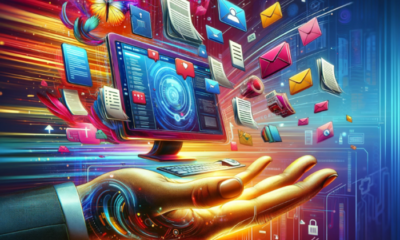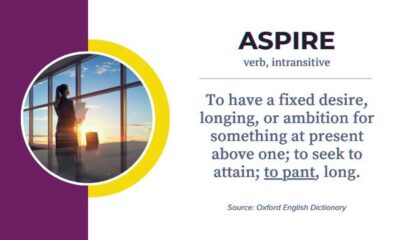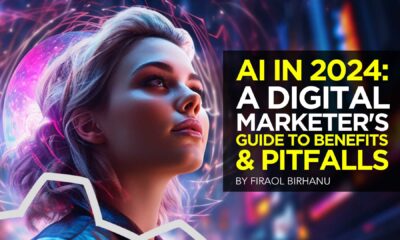MARKETING
10 Great Testimonial Examples From Landing Pages
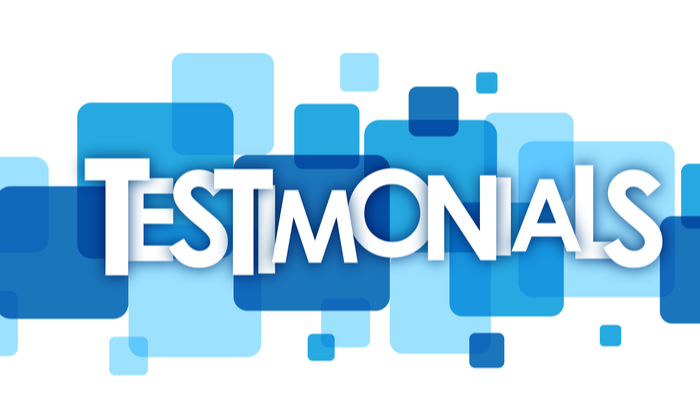
Landing pages help drive traffic, increase conversions, and improve SEO. However, not all landing pages are effective. If your landing pages aren’t producing results, the issue might not be your copy or your product—it might be because you aren’t using testimonials efficiently.
Below, we’ll look at ten different landing page testimonial examples and discuss why they work and how they build trust. First, let’s cover why they matter so much for brands.
Why Should You Include Testimonials on Your Landing Page?
The primary purpose of a landing page is to convert visitors and move them through your sales funnel. Ideally, you’ll have fantastic copy to convince customers you can solve their problems.
However, consumers don’t trust brands—they trust other people. According to the Edelman Trust Barometer Special Report, only one-third of consumers trust brands to do the best they can for their customers and the world at large.
Who do they trust? Other consumers. In fact, 92 percent of consumers report they trust word-of-mouth marketing more than any other type of marketing.
Testimonials on landing pages can also help:
- increase relevance by mentioning specific pain points the customer is facing
- drive conversions, as consumers who read testimonials, are 58 percent more likely to convert
- showcase important features in an easy-to-read format
- establish use cases that might not be highlighted in marketing copy
10 Testimonial Examples Used on Landing Pages
Including testimonials on a landing page is a powerful way to increase trust, drive clicks, and overcome objections. How those testimonials are formatted, however, can drastically impact how well they reach those goals.
The testimonial examples below showcase a few of the most effective ways to successfully use testimonials based on the audience and landing page type.
1. Blue Apron Uses Changing Testimonials
Blue Apron, an at-home meal kit company, leverages the power of testimonials on its pricing page in a unique way. The testimonials are plain text with no images. However, they still stand out.
Here’s the first testimonial on the page:
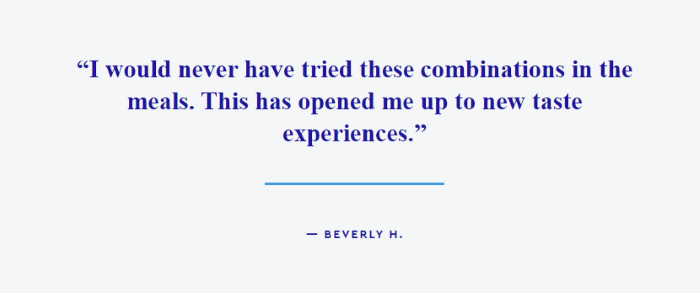
It highlights the novelty of the meal kits, which encourages users who might think they’ll get bored. A few seconds later, the testimonial changes to this one:
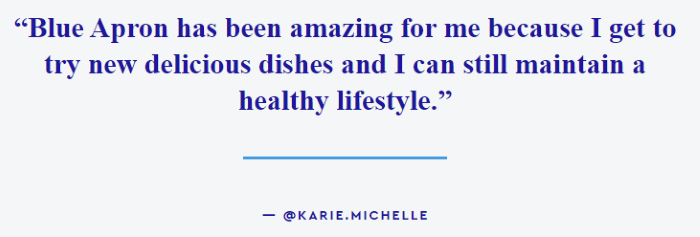
This testimonial focuses on how healthy the meals are, which is ideal for customers worried about their health. By changing the testimonials every few seconds, Blue Apron can show a variety of reviews to potentially address different consumers’ pain points. The change is also visually appealing, which grabs viewers’ attention.
2. Business-Software.com Offers Authorative Testimonials
Business-Software.com is dedicated to providing buyers and vendors with incredibly detailed reviews of popular business technology. On their landing page about Salesforce, a popular sales and marketing tool, they use a testimonial to highlight one of their reports.
In addition to being visually appealing due to bright colors and clean icons, the testimonial is powerful for another way because it’s from a recognizable, authoritative person in the field: James White of Active Spectrum.
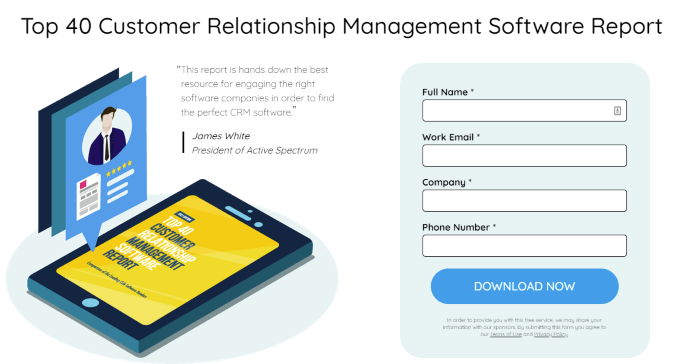
Using a testimonial from an authority figure helps establish trust. People often assume if someone in a position of authority likes a product, service, or piece of work, there’s a good chance we will too.
Putting the review next to a download form is also an interesting strategy. Most brands use testimonials to drive sales, not leads. However, this can be effective at enticing leads by encouraging them to fill out forms.
3. MarketerHire Increases Trust
MarketerHire is a company dedicated to connecting companies and marketers. The testimonials MarketHire features on their site specifically show how they help address pain points.

These testimonials address concerns about how difficult the service may be to use, worries about hiring during difficult times, and anxiety about trying a service like MarketerHire in general. Knowing other users have similar pain points and found MarketerHire to be an effective solution can establish trust.
The images of each testimonial provider and their name and position also help readers trust that these reviews are real and accurate. The images and logos are also eye-catching and invite scrollers to have a closer look.
4. InseevInteractive Offers More Testimonials Without Taking up More Space
If a few testimonials are good, a lot of testimonials should be great, right? That’s not entirely true.
If you want to include testimonials on your landing page, just be sure to not include too many. Going over-board with the testimonial examples can overwhelm your leads and they could move with your competitor.
InseevInteractive, a marketing company, found a way around this challenge by installing buttons that allowed visitors to see more testimonials or read long-form case studies.
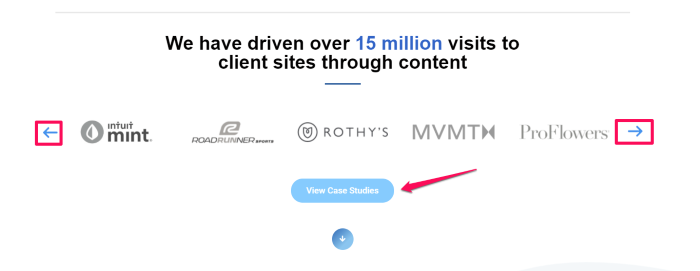
This testimonial example leverages the power of social proof while keeping customers who are ready to convert on task. If a customer needs a bit more information, they can easily click to read more.
As powerful as testimonials are, it’s crucial not to pull people out of your sales funnel with distracting elements. This testimonial example walks that fine line perfectly.
5. Teamwork Includes Eye-Catching Trust Signals
Teamwork is a project management tool designed to grow with businesses, making it ideal for small businesses and startups. However, there are dozens of similar tools on the market. Where do they stand out?
One factor that differentiates them is their use of testimonials
Teamwork features two testimonial sections on their landing page. The first includes an image of the person and a short review:
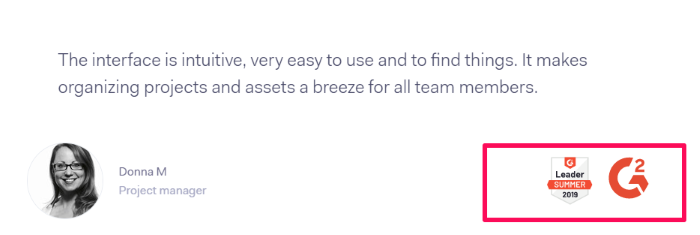
This testimonial example stands out because of the trust symbols Teamwork uses under Donna’s review. These showcase the tool as a reliable, award-winning tool. They are also bright and grab the eye as users scroll down.
Then, further down the page, they include more testimonials from Twitter.
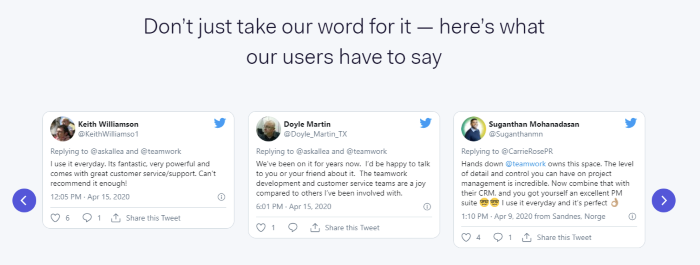
Sharing Tweets, which can be verified if readers want to do some extra legwork, establishes trust in the brand. Teamwork also uses the buttons on either side of the Tweets, which allow users to scroll through more testimonials if they so choose.
Offering more testimonials without overwhelming a whole page with them is powerful because it shows a wide range of people like your product. It gives prospects a chance to find a review that addresses their concerns.
6. Topic Uses an Eye-Catching Design
Topic is an AI-powered content tool designed to help brands create better quality content fast. They leverage the power of testimonials by including a ton of testimonials on their landing page:
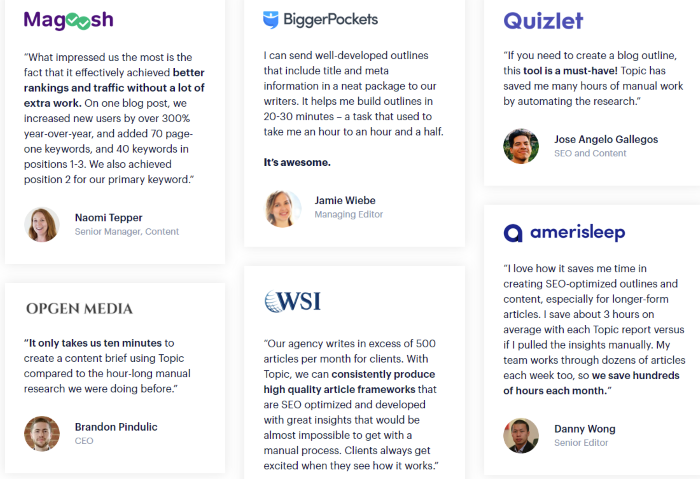
These testimonials stand out due to the careful attention to design. Each review includes the image, full name, and position of the reviewer, which can establish trust and give the section a clean, professional look.
Each review is split up into cards to keep them organized and easy to read. The logos and small profile images are visually appealing and draw the eye to each review.
This testimonial example is powerful for several reasons: the design is on point, the reviews are eye-catching, and they leverage several other strategies, like using authoritative reviewers and including images.
7. Booker Adds Five Stars to Grab Attention
The vast majority of internet users don’t read; they skim. Booker, a business management platform for beauty companies, found a way to capture scanners’ attention while also leveraging the power of testimonials.
They use several testimonial examples to highlight what people love about their software on their business management landing page.
In addition to the companies’ names and short testimonials, they include icons and star ratings.
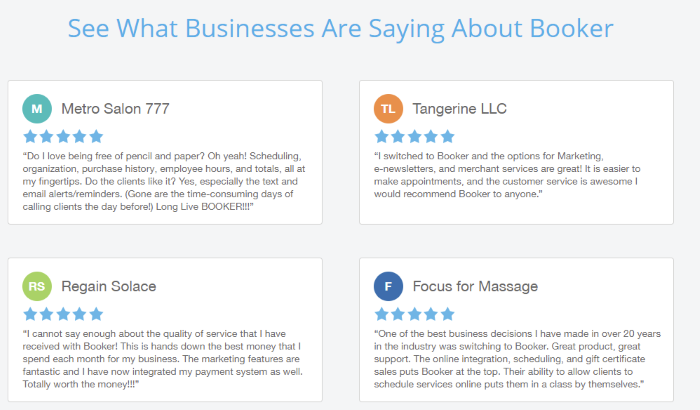
The five-stars allow users just scrolling by to easily see what reviewers think of Booker without having to stop and read the entire review.
This testimonial format strikes the perfect balance between trust by offering longer written testimonials and giving users the information they need at a glance by including the five-star rating.
8. Display User’s Testimonials on Different Landing Pages
Keap is a CRM designed for small businesses that want to leverage automation in their sales processes. They offer several landing pages for each feature, including CRM, automation, reporting, and analytics.
Each landing page includes several testimonials where current customers share what they love best about Keap. However, they don’t use the same testimonials on each page.
For example, on their automation landing page, each testimonial mentions how Keap’s automation features help save the users’ time.
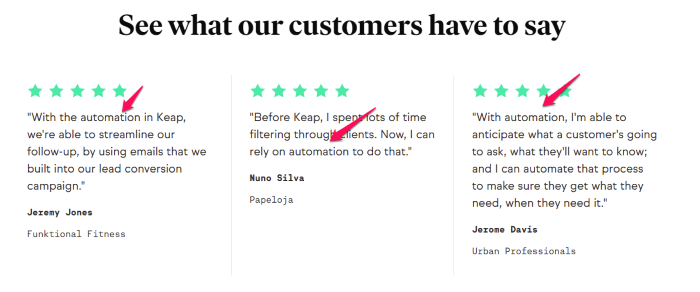
Like Booker, they include five-star icons, which grabs attention and allows people scanning the page to see how much the tool is loved.
By offering different reviews on each page, Keap provides relevant testimonials to each customer persona.
9. Salesflare Uses Pictures to Increase Trust
Salesflare is a powerful CRM designed specifically to help B2B businesses grow. The brand uses a simple landing page to drive conversions by offering a picture of the platform, an icon-rich features list, and several testimonials.
Unlike other testimonials, which are often several lines long, Salesflare keeps it simple by using one or two lines for each testimonial. They also include profile pictures, full names, and the the name of the company that completed the review.
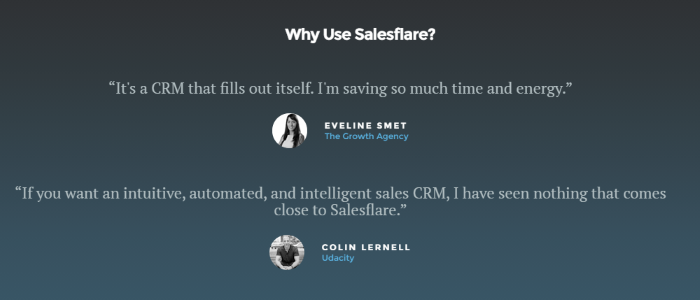
In some cases, using longer testimonials might be more effective. However, on this page, Salesflare relies on the images and brand names to increase trust and grab readers’ attention.
10. Lattice Combines Testimonial Types for a Powerful Punch
Lattice is an HR management platform used by some of the biggest brands in the world. Their testimonial section packs a big punch by using three different testimonial types, all in one easy-to-view section.
First, they list the names of big brands they work with, including Reddit, Slack, and Asana. Knowing those well-established brands use this tool helps inspire trust—they obviously aren’t new to the industry.
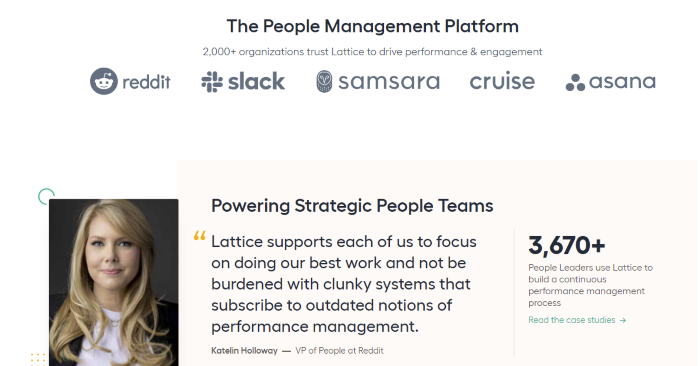
The next section offers an individual review from a reputable source: the VP of People of Reddit. Knowing she trusts Lattice may help readers feel confident it’s a trustworthy solution. They also include an image, which shows her face and helps viewers connect with the review with the human who gave it.
Finally, on the right side, they offer a link to read case studies and list how many people use their company.
Lattice’s testimonial section works incredibly well because it includes a lot of information and several forms of testimonials but keeps the design sleek and easy to read.
Conclusion
Many brands don’t effectively use testimonials on landing pages, if they use them at all. The testimonial examples above serve as inspiration for using testimonials on your own landing pages.
Keep in mind that testimonials don’t work in a vacuum; they should only be one aspect of your digital marketing strategy. For example, you may benefit from beefing up your social media strategy, carrying out marketing campaigns, publishing blog posts that help users find your business organically, and analyze/fix any SEO issues.
If this sounds overwhelming and you need help developing or improving your marketing strategies, reach out. Our agency is happy to help in whatever capacity you need.
Do you use testimonials on your landing pages? What impact have they had on your conversions?
See How My Agency Can Drive Massive Amounts of Traffic to Your Website
- SEO – unlock massive amounts of SEO traffic. See real results.
- Content Marketing – our team creates epic content that will get shared, get links, and attract traffic.
- Paid Media – effective paid strategies with clear ROI.
MARKETING
The key to correcting the C-suite trust deficit
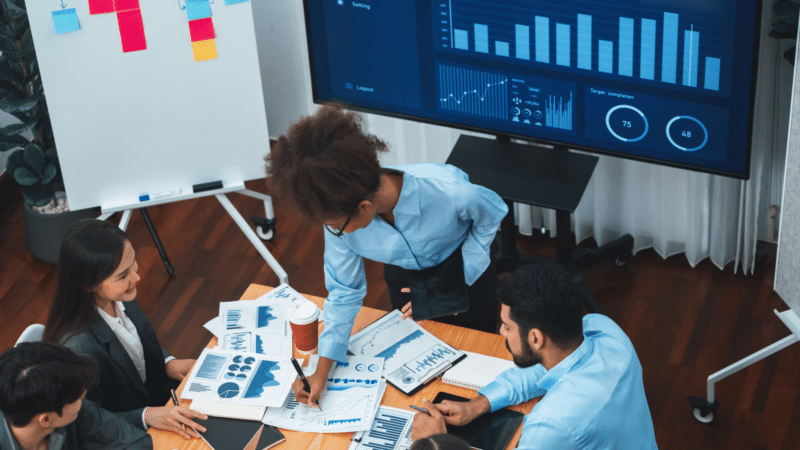
Take a moment to search “CMO tenure” and you’ll find a wide variety of content discussing the short tenure of CMOs and how it’s among the shortest of roles in the C-suite. If you dive deeper, you’ll find that CEOs don’t seem to trust CMOs.
Boathouse’s CMO Insights study (registration required) noted several sobering conclusions:
- 34% of CEOs have great confidence in their CMOs.
- 32% of CEOs trust their CMOs.
- 56% of CEOs believe their CMO supports their long-term vision.
- And only 10% of CEOs believe their CMO puts the CEO’s needs before their own.
If these statistics also apply to the CMO’s entire organization, then it’s clear we have a trust problem with marketing leadership.
If you haven’t read Patrick Lencioni’s “The Five Dysfunctions of a Team,” I consider it required reading for anyone in any leadership role. In his book, Lencioni builds a pyramid of dysfunctions that need to be addressed for a team to succeed. The foundational dysfunction — with which one cannot build a successful team — is “absence of trust.” We see it at scale with marketing organizations today.
Introducing objectivity through data
In “Hamlet,” Shakespeare writes, “There is nothing either good or bad, but thinking makes it so.” Each organization that makes up a company looks at the company from a different perspective. What marketing sees as positive, finance may see as negative. But who’s right? No one.
Usually, there is no objectivity because leadership comes up with an idea and we execute it. It’s like the fashion proverb “Beauty is in the eye of the beholder.” Unfortunately, we’re going to struggle to run a profitable organization if it’s run like a fashion show.
Therefore, we need to introduce objectivity to how we work. Leadership needs to come together to agree on goals that align with the goals of the broader organization. One element of this conversation should be an acknowledgment that this is turning a ship.
Often leaders — especially those without marketing backgrounds — are likely to expect instant gratification. It’s going to take time to turn the ship and you and your team would do well to set reasonable expectations right away.
Dig deeper: KPIs that connect: 5 metrics for marketing, sales and product alignment
Aligning goals and metrics across the organization
With goals in hand, we need to assign metrics to their progress and agree on the source(s) of truth. Once these objective measures are in place, perspective doesn’t matter. 2 + 2 = 4 regardless of whether you’re in HR or accounting.
Every public road has a speed limit and whether you’re in compliance with it has nothing to do with your perspective. If you’re above it, you’re wrong and subject to penalties. Referring to the fashion example, it’s not a fashion show where some people like a dress and others don’t.
By using data to objectively measure marketing’s progress within the organization and having the rest of the leadership buy into the strategy, we build trust through objectivity. Maybe the CEO would not have chosen the campaign the marketing team chose.
But if it was agreed that a >1 ROAS is how we measure a successful campaign, it can’t be argued that the campaign was unsuccessful if the ROAS was >1. In this example, the campaign was an objective success even if the CEO’s subjective opinion was negative.
Data-driven campaign planning
Within the marketing organization, campaigns should always be developed with measurement top of mind. Through analysis, we can determine what channels, creative, audiences and tactics will be most successful for a given campaign.
Being able to tell the leadership team that campaigns are chosen based on their ability to deliver measured results across metrics aligned to cross-departmental goals is a powerful message. It further builds trust and confidence that marketing isn’t run based on the CMO’s subjective opinions or gut decisions. Rather, it’s a collaborative, data-driven process.
For this to be successful, though, it can’t just be for show, where we make a gut decision and direct an analyst to go find data to back up our approach. This would be analytics theater, which is a perversion of the data. Instead, tell the analyst what you think you want to do and ask them to assess it.
For the rest of the organization’s leadership, ask questions when the marketing team presents a campaign. Find out how they came up with the strategy and expect to hear a lot about data — especially the metrics you all agreed would support the company’s overarching goals.
Dig deeper: 5 failure points of a marketing measurement plan — and how to fix them
Data literacy: Building credibility through transparency
Building trust doesn’t happen overnight, but a sustained practice of using data to drive marketing leadership’s decisions will build trust if the metrics ladder up to the organizational goals and all of leadership is bought into the measurement plan.
Over time, this trust will translate into longer tenure and more successful teams through building the infrastructure needed to tackle Lencioni’s five dysfunctions.
Opinions expressed in this article are those of the guest author and not necessarily MarTech. Staff authors are listed here.
MARKETING
How Tagging Strategies Transform Marketing Campaigns

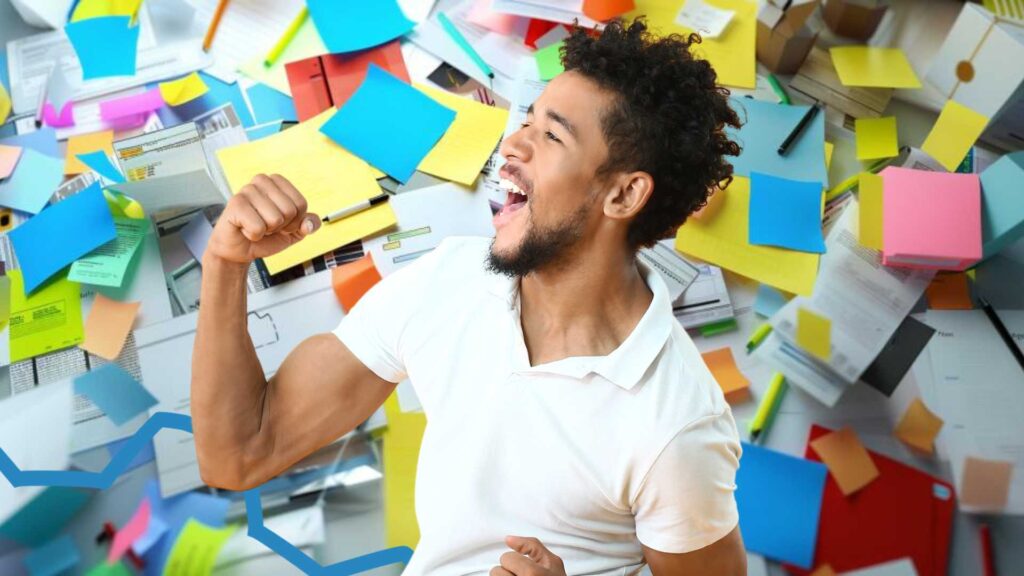
As a marketer, I understand how today’s marketing campaigns face fierce competition. With so much content and ads competing for eyeballs, creating campaigns that stand out is no easy task.
That’s where strategies like tagging come in.
It helps you categorize and optimize your marketing efforts. It also helps your campaigns cut through the noise and reach the right audience.
To help you out, I’ve compiled nine ways brands use a tagging strategy to create an impactful marketing campaign.
Let’s get to it.
How Brands Use a Tagging Strategy
Tagging involves using keywords or labels to categorize and organize content, products, or customer data. You attach tags to specific items or information to make searching, sorting, and analyzing data easier.
There are various types of tags, including meta tags, analytics tags, image tags, hashtags, blog tags, and more.
So, how do brands use a tagging strategy to make their marketing campaigns stand out?
Improve Social Media Engagement
With over 5 billion users, social media provides an easy way to connect with your audience, build relationships, and promote your offerings.


Use a tagging strategy to boost social media interactions. Consistently use hashtags that align with current trends and topics. This encourages people to interact with your content and boosts content visibility.
You can also use tags to monitor brand mentions of your products or your industry. This allows you to engage with your audience promptly.
Consider virtual social media assistants to streamline your tagging strategy. These AI-driven tools can suggest relevant hashtags, track mentions, and automate responses. Implementing them can save time and resources while ensuring consistent engagement across your socials.
Build a Personal Brand on LinkedIn
LinkedIn is the world’s largest professional networking platform, with over 1 billion members across 200 nations. It offers excellent opportunities for individuals and businesses to build and nurture their brands.
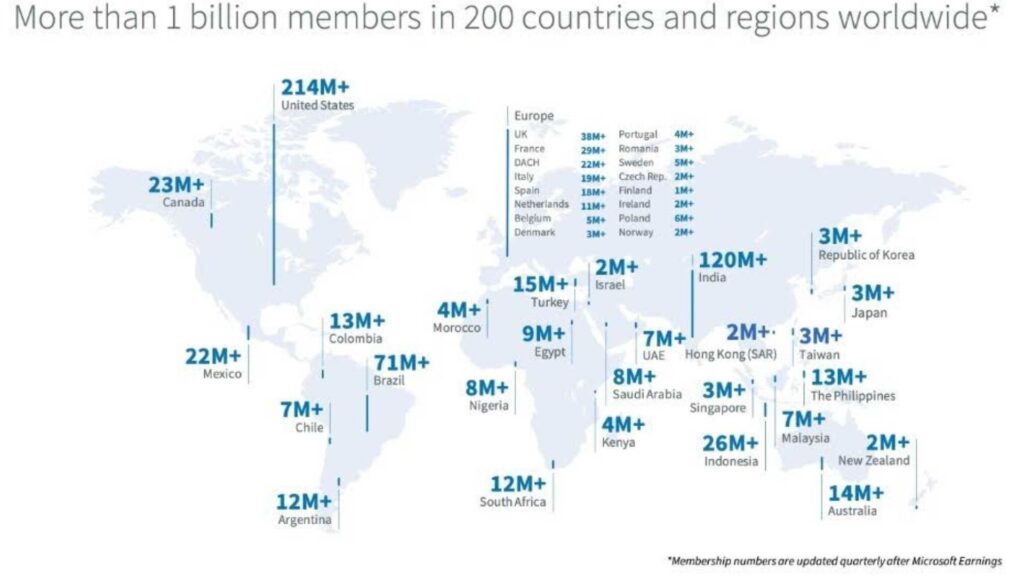

However, simply creating a professional profile isn’t enough to build a personal brand on LinkedIn.
Use various tags to increase your visibility, establish thought leadership, showcase expertise, and attract the right connections. For instance, use skill tags to showcase your expertise and industry tags to attract connections and opportunities within your industry. Use certification tags to help showcase your expertise and credibility to potential employers or clients.
Facilitate Customer Segmentation and Personalization
Personalization matters—more so in today’s data-driven world. In fact, 65% of consumers expect your brand to adapt to their changing preferences and needs.
To meet this expectation, consider using a tagging strategy.
Segment your customers based on shared characteristics, such as demographics, interests, purchase history, cart abandonment, and behavior.
Here’s a summary of the steps to customer segmentation.
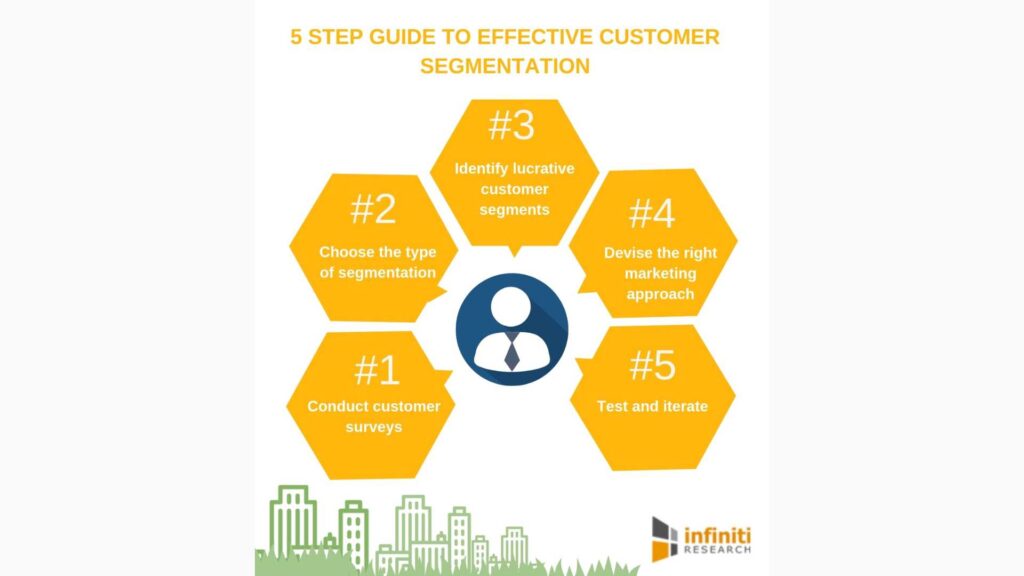

With your customer segments ready, use tags to tailor your marketing messages and offerings to specific segments. Imagine sending targeted email campaigns based on what your customers need. That’s the power of segmentation and tagging in action!
Enhance SEO and Content Discoverability
Tagging content can have a profound impact on search engine optimization (SEO) and content discoverability. When users search for specific topics or products, well-tagged content is more likely to appear in search results, driving organic traffic to your website.
Additionally, tags can help you analyze the most popular topics with your readers. Then, the results of this analysis can help you adjust your content strategies accordingly.
And get this— certain AI tools can help analyze your content and suggest relevant tags and keywords. Using these tools in addition to a tagging strategy can help optimize your SEO strategies and boost content discoverability.
Partner with the Right Influencers
Influencer marketing has become a go-to marketing approach for modern brands. Recent stats show that 85% of marketers and business owners believe influencer marketing is an effective marketing strategy.
But how do you find the perfect influencer for your campaign?
Utilize tags to identify influencers who are relevant to your niche. Beyond this, find influencers who align with your brand values and target audience.
Additionally, look for influencers who use hashtags that are relevant to your campaigns. For instance, fashion influencer Chiara Ferragni uses #adv (advertising) and #ghd (good hair day) hashtags in this campaign.
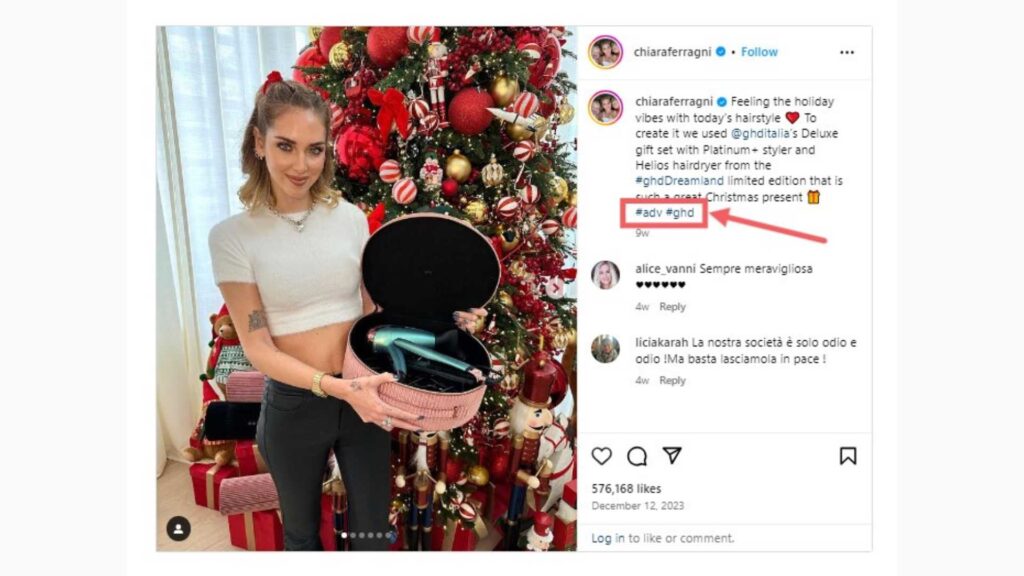

Monitor industry-specific hashtags and mentions to discover influential voices and build profitable relationships with them.
Track Hashtag Performance
Tracking your hashtag performance helps you understand your campaigns’ engagement, reach, and effectiveness.
To achieve this goal, assign special hashtags to each marketing project. This helps you see which hashtags generate the most engagement and reach, enabling you to refine your tagging strategy.
Here’s an example of a hashtag performance report for the #SuperBowl2024.
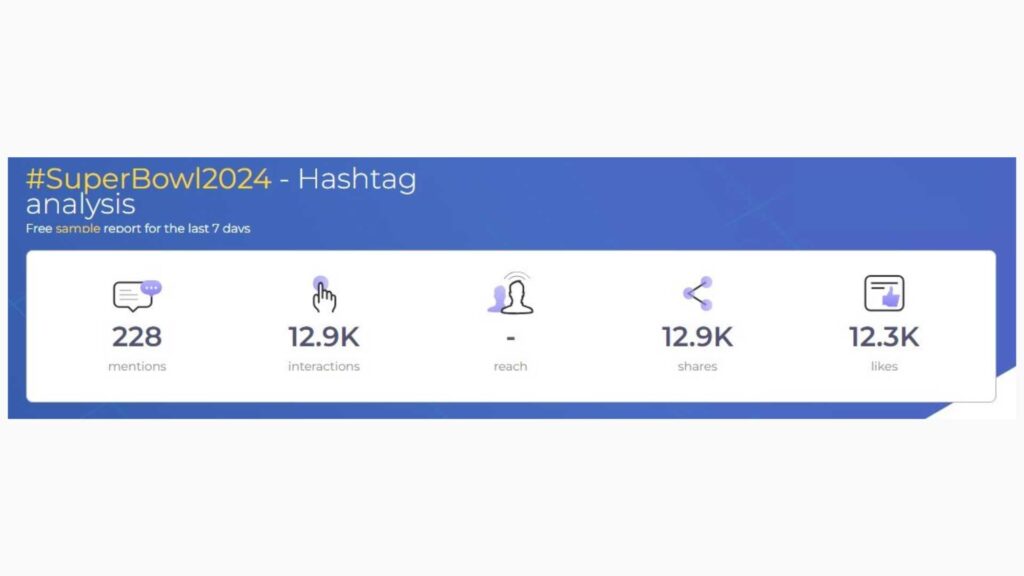

This curated list of hashtag generators by Attrock discusses the top tools for your consideration. You can analyze each and choose the one that best fits your needs.
Categorize Content Accordingly
The human attention span is shrinking. The last thing you want is for your audience to have difficulty in finding or navigating your content, get frustrated, and bounce.
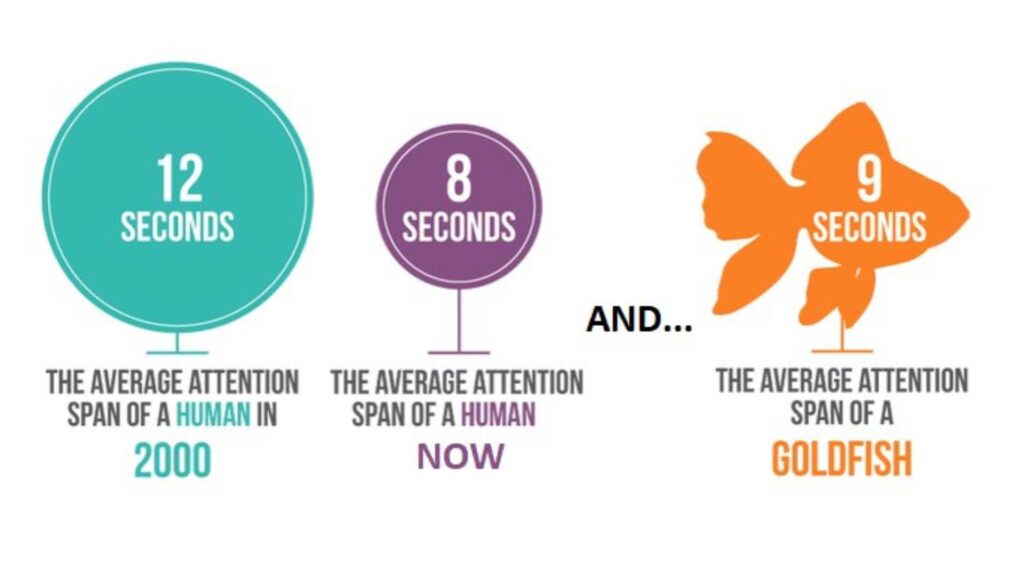

Untagged content can be difficult to navigate and manage. As any marketer knows, content is important in digital marketing campaigns.
To categorize your content, identify the main categories by topics, themes, campaigns, target audiences, or product lines. Then, assign relevant tags based on the categories you’ve identified. After that, implement a consistent tagging strategy for existing and new content.
Organizing your content using tags can also help streamline your content management workflow. Most importantly, readers can easily find the content they’re looking for, thereby boosting overall user experience, engagement, and conversions.
Boost Your Email Marketing Strategy
Email marketing remains a powerful marketing tool in today’s digital world. It’s also another area where brands use a tagging strategy to directly reach their target audience.
Use tags to segment your email list and personalize your marketing messages. Then, you can send targeted emails based on factors like purchase history, interests, and demographics.
Personalization can significantly improve open rates, CTRs, and overall engagement and conversion rates. It’s a simple yet impactful strategy to make your email marketing strategy more effective.
Plus, you can use tags to track how well your emails perform with each group. This helps you understand what content resonates best with your audience and provides insight on how to improve your emails going forward.
Enhance Analytics and Reporting
Every marketer appreciates the immense value of data. For brands using tagging strategies, tags are powerful tools for gathering valuable data.
Analyze how users interact with your tagged content. See which tags generate the most clicks, shares, conversions, and other forms of engagement. Gain insight into audience preferences and campaign effectiveness.
This granular data about your marketing efforts allow you to make data-driven decisions, allocate resources effectively, and refine your marketing strategies.
Final Thoughts
There isn’t a single correct way for brands to use a tagging strategy in marketing. You can use a tagging strategy however you see fit. However, the bottom line is that this strategy offers you a simple yet powerful way to create attention-grabbing and unique marketing campaigns.
Fortunately, tagging strategies are useful across various marketing initiatives, from social media and email marketing to SEO and more.
So, if you’re ready to elevate your marketing campaign, build a strong brand presence, and stand out among the competition, consider employing effective tagging strategies today.
MARKETING
Tinuiti Recognized in Forrester Report for Media Management Excellence
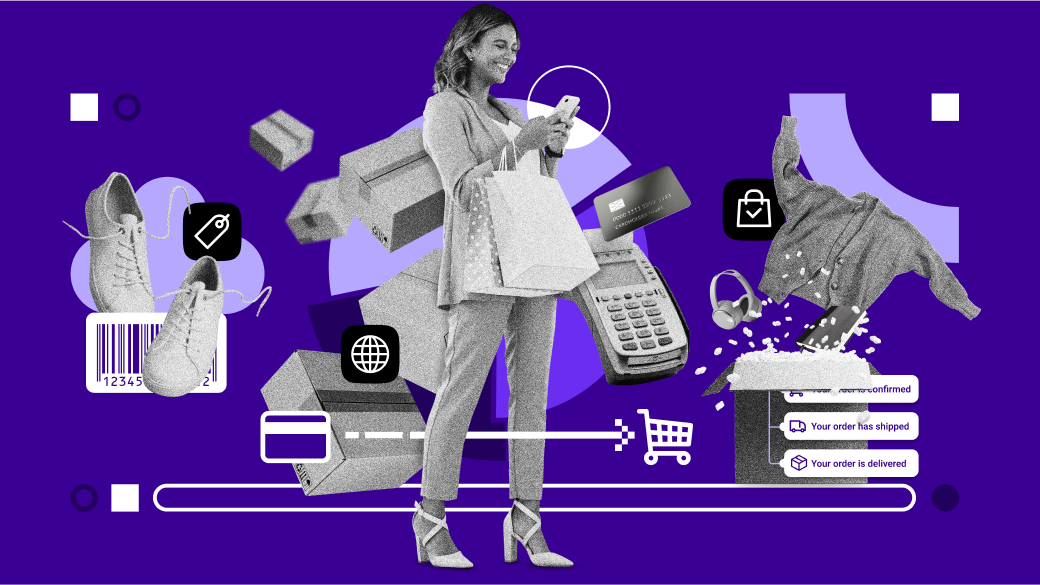
Tinuiti, the largest independent full-funnel performance marketing agency, has been included in a recent Forrester Research report titled, “The Media Management Services Landscape, Q2 2024.” In an overview of 37 notable providers, this comprehensive report focuses on the value B2C marketing leaders can expect from a media management service provider, and analyzes key factors to consider when looking for a media management partner such as size and business scenarios. B2C marketing executives rely on media management services to:
- Augment the efficacy of media investments
- Bridge media impressions to commerce transactions
- Enhance ad campaigns to drive performance
Report authors, VP, Principal Analyst Jay Pattisall and Senior Analyst Nikhil Lai call attention to the pressing need for providers to prove their value, deliver profitable ROAS, and drive alignment between CMOs and CFOs and thus liberate strained marketing budgets.
Our Always-On Incrementality tool – which is a part of our patented tech, Bliss Point by Tinuiti – empowers marketers to validate the incrementality of their spend on each ad set, media channel, and marketing tactic so marketers can create stronger, more focused campaigns that get the job done without sacrificing the bottomline.
B2C marketing leaders often seek and expect key business scenarios from media management service providers including media measurement and attribution, data strategy, and marketing mix modeling. MMM’s adaptability to the post-cookie/ post-IDFA world positions it as an essential tool for marketers. As businesses seek to connect the dots, leverage data, and make strategic decisions, MMM is a crucial ally in the dynamic realm of mixed media advertising. Our Rapid Media Mix Modeling sets a new standard in the market with its exceptional speed, precision, and transparency.
According to the Forrester report, “46% of senior B2C marketing and advertising decision-makers say they plan to integrate performance and brand media assignments with a single media agency in the next 12 months…”
In our quest to better understand all revenue-driving aspects of a given campaign, we have started on a process to quantify the impact of Brand Equity, which we believe is one of the largest missing pieces in more accurate and complete measurement.
Learn more about Bliss Point by Tinuiti, our use cases, and our approach to performance and brand equity.
The Landscape report is available online to Forrester customers or for purchase here.
-
SEARCHENGINES7 days ago
Daily Search Forum Recap: April 29, 2024
-
SEARCHENGINES6 days ago
Daily Search Forum Recap: April 30, 2024
-

 MARKETING5 days ago
MARKETING5 days agoHow To Develop a Great Creative Brief and Get On-Target Content
-
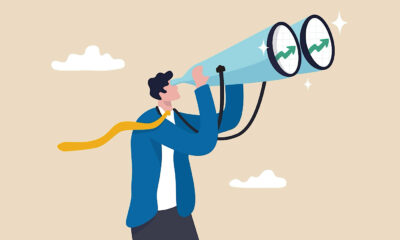
 SEO7 days ago
SEO7 days agoGoogle’s John Mueller On Website Recovery After Core Updates
-

 WORDPRESS6 days ago
WORDPRESS6 days ago13 Best Fun WordPress Plugins You’re Missing Out On
-
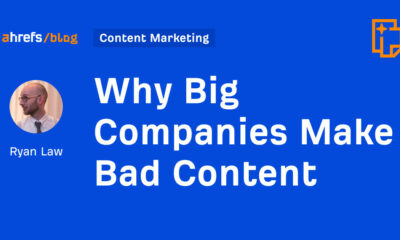
 SEO5 days ago
SEO5 days agoWhy Big Companies Make Bad Content
-
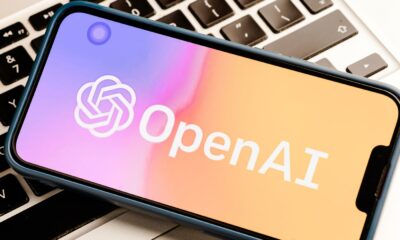
 SEO6 days ago
SEO6 days agoOpenAI To Show Content & Links In Response To Queries
-

 SEO5 days ago
SEO5 days agoHow To Drive Pipeline With A Silo-Free Strategy


